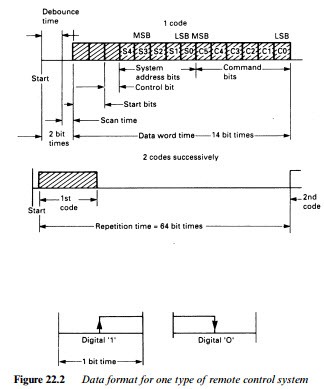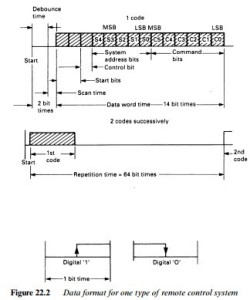MULTI-FUNCTION REMOTE CONTROLLER
In the description above, mention was made of the address code, which forms the third section of the RC command word. By chang- ing the address codes and programming receiving decoders accord- ingly, the three bits offer eight possible addresses, which means that eight different pieces of equipment can be operated by the same handset. A more sophisticated application of the same technology is embodied in a multi-function encoder/transmitter IC, which can handle up to 2048 separate commands, placed in 32 addressable groups of 64 commands each. The transmitter has a similar start/ debounce cycle to that already described. Here the code is transmit- ted in bi-phase form, whereby a digital 1 is signalled by a rise in potential during one bit period, and a digital 0 by a fall in potential during one bit period. See Fig. 22.2. Each bit period is 1.78 ms, and as long as a key is depressed the data word is transmitted at intervals of 64 bit periods, 114 ms.
The bit structure for the transmitted code is shown in Fig. 22.2. The first two bit periods are occupied with debounce and key scan- ning. The transmission begins with two start bits to set the operating point in the receiver’s a.g.c. circuit, followed by a control bit (similar to the previously described toggle bit) to indicate a new transmis- sion. There follow five system address bits S0–S4 which can be set by a selector switch on the handset or (for ‘dedicated commander’ applications) hard-wired in one of the 32 possible configurations. The command is conveyed by the next five bits C0–C5.
Because of the large number of possible slaves for this system, and
to ensure standardisation between different manufacturers’ equipment using it, the address codes have been standardised by the IC maker as shown in Table 22.1. The command codes have also been- standardised so that the same (symbol marked) buttons on the handset are relevant to all equipment addressed. Thus ‘play’ command code 110101 will be recognised by videorecorder, disc player, audio cassette player etc. once correctly addressed, as will ‘volume up’ (010000) ‘go to standby’ 001100 etc., the latter two commands also being relevant to a TV set.

